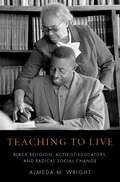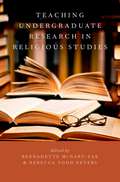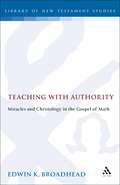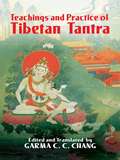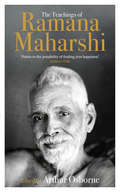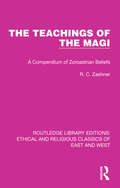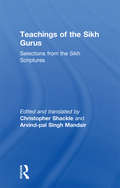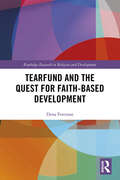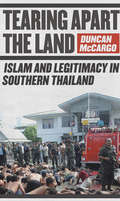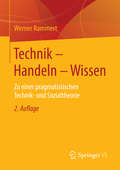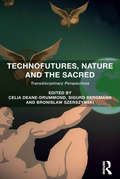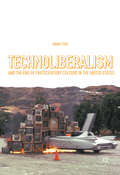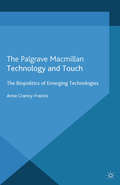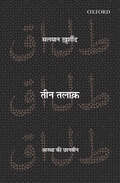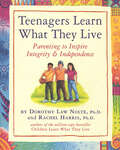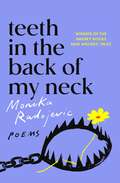- Table View
- List View
Teaching to Live: Black Religion, Activist-Educators, and Radical Social Change
by Almeda M. WrightTeaching to Live: Black Religion, Activist-Educators, and Radical Social Change interrogates the stories of African American activist-educators whose faith convictions inspired them to educate in radical and transformative ways. Many of these educators are known only or primarily for their educational theory or activism, and their religious convictions have often been obscured or outright ignored. Almeda M. Wright seeks to rectify this omission, exploring the connections between religion, education, and struggles for freedom within twentieth-century African American communities by telling the stories of key African American teachers. Wright brings together the lives and work of three related subgroups of activist-educators: those who worked in public or secular education but were religiously inspired; radical scholars who transformed the ways that Black religion and Black religious life are studied and valued; and radical religious educators, or those educators who were involved more formally with the religious formation of Black people but who regarded this work of spiritual development as part of the struggle for freedom and liberation of all people. She begins with the reflections of Anna Julia Cooper, W. E. B. Du Bois, Ida B. Wells, and Nannie Helen Burroughs, who attempted to transform American society by expanding the involvement of African Americans as contributors to all aspects of American life, especially the religious, intellectual, and cultural spheres. Wright also examines the activist-educators at the center of the mid-twentieth-century Civil Rights Movement, such as the religious and lay leaders Septima Clark and James Lawson, and the cadre of student leaders and teachers they trained. Finally, she investigates how the models of religious activist-educators Olivia Pearl Stokes and Albert Cleage emerged in the last quarter of the twentieth century at the same time that questions about the centrality of Black Christianity in the African American community and Black activism began to take shape. The rich and complex narratives of these educators show how religion, education, and radical social change can intersect. This book invites readers to continue exploring how these concepts will evolve for future generations of activist-educators.
Teaching Undergraduate Research in Religious Studies (AAR Teaching Religious Studies)
by Bernadette McNary-Zak Rebecca Todd PetersTeaching Undergraduate Research in Religious Studies offers an introduction to the philosophy and practice of Undergraduate Research in Religious Studies and takes up several significant ongoing questions related to it. For those new to Undergraduate Research, it provides an overview of fundamental issues and pedagogical questions and practical models for application in the classroom. For seasoned mentors, the book acts as a dialogue partner on emerging issues and offers insight into pertinent questions in the field based on experience of recognized experts.
Teaching with Authority: Miracles and Christology in the Gospel of Mark (The Library of New Testament Studies #74)
by Edwin K. BroadheadThe foundational inquiries into the relationship of miracles and Christology by Wrede, Dibelius, Bultmann and Marxsen guided a productive half-century of critical research. Their work raised crucial issues concerning the nature of the Gospels and the proper methods of interpretation that have in many ways charted the direction for New Testament studies. A new principle is now to be added to their criteria, however, that strategies of interpretation must be consciously shaped to highlight the features of narrative and its christological focus. The author then employs a consistent narrative strategy of interpretation in order to re-evaluate the relation of miracles and Christology in the Gospel of Mark. The primary goal is reconsideration of the role played by miracle stories in the characterization of Jesus. In particular, the tension posed by recent scholarship between the Jesus of the miracles and the Jesus of the cross is shown to be a false dichotomy.
Teachings and Practice of Tibetan Tantra
by John C. Wilson Garma C. ChangA lifestyle and way of acknowledging one's sensual and spiritual self, Tantric Buddhism preaches the satisfaction of all desires. Step-by-step instructions demonstrate how to perform traditional yoga exercises and provide practical applications for expanding and liberating one's consciousness. Essentially an explanation of surrendering all mental, emotional, and cultural conditionings, the concise guide describes the art of spiritualizing one's sexuality and at the same time offers efficient methods for transmuting fear and attachment into love and universal power.
The Teachings of Ramana Maharshi (The Classic Collection)
by Arthur OsborneSri Ramana Maharshi is widely thought of as one of the most outstanding Indian spiritual leaders of recent times. Having attained enlightenment at the age of 16, he was drawn to the holy mountain of Arunachala in southern India, and remained there for the rest of his life. Attracted by his stillness, quietness and teachings, thousands sought his guidance on issues ranging from the nature of God to daily life.This book brings together many of the conversations Maharshi had with his followers in an intimate portrait of his beliefs and teachings. Through these conversations, readers will discover Maharshi's simple discipline of self-enquiry: knowing oneself and looking inwards as the road to true understanding and enlightenment. This updated edition will appeal to anyone looking for peace, self-awareness, and guidance on how to embrace the self for well being and calm.
The Teachings of the Magi: A Compendium of Zoroastrian Beliefs (Ethical and Religious Classics of East and West #10)
by R. C. ZaehnerOriginally published in 1956, this book provides a clear, scholarly, introduction to the main tenets of Zoroastrian dualism presented largely in the words of the Zoroastrian texts themselves. The book demonstrates the essential reasonableness of Zoroastrian dualism, which is the dualism of a good and an evil spirit, and to show what the means in everyday life and how it is philosophically justified. There are chapters on cosmology, the relation of man to God, the nature of religion, ethics, sacraments and sacrifice, the soul’s fate at death and eschatology.
The Teachings of the Magi: A Compendium of Zoroastrian Beliefs (Ethical and Religious Classics of East and West #10)
by R. C. ZaehnerOriginally published in 1956, this book provides a clear, scholarly, introduction to the main tenets of Zoroastrian dualism presented largely in the words of the Zoroastrian texts themselves. The book demonstrates the essential reasonableness of Zoroastrian dualism, which is the dualism of a good and an evil spirit, and to show what the means in everyday life and how it is philosophically justified. There are chapters on cosmology, the relation of man to God, the nature of religion, ethics, sacraments and sacrifice, the soul’s fate at death and eschatology.
Teachings of the Sikh Gurus: Selections from the Sikh Scriptures
by Christopher Shackle Arvind MandairRecognized masterpieces of Indian literature, the Guru Granth Sahib and the Dasam Granth are fundamental to the Sikh religion, not only in the physical layout of temples and in ceremonies of worship, but as infallible reference texts offering counsel and instruction. Teachings of the Sikh Gurus presents a brand new selection of key passages from these sacred scriptures, translated into modern English by leading experts, Christopher Shackle and Arvind-pal Singh Mandair. Including six longer compositions and many shorter hymns thematically organised by topics such as Time and Impermanence, Self and Mind, Authority, and Ethics, the book’s accessible and carefully chosen extracts distil the essence of Sikhism’s remarkable textual and intellectual legacy, depicting how its message of universal tolerance suits the contemporary world. The detailed introduction and notes to the translations aid readers’ comprehension of the hymns’ form and content, as well as providing some historical context, making it an ideal introduction to Sikh literature.
Teachings of the Sikh Gurus: Selections from the Sikh Scriptures
by Christopher Shackle Arvind MandairRecognized masterpieces of Indian literature, the Guru Granth Sahib and the Dasam Granth are fundamental to the Sikh religion, not only in the physical layout of temples and in ceremonies of worship, but as infallible reference texts offering counsel and instruction. Teachings of the Sikh Gurus presents a brand new selection of key passages from these sacred scriptures, translated into modern English by leading experts, Christopher Shackle and Arvind-pal Singh Mandair. Including six longer compositions and many shorter hymns thematically organised by topics such as Time and Impermanence, Self and Mind, Authority, and Ethics, the book’s accessible and carefully chosen extracts distil the essence of Sikhism’s remarkable textual and intellectual legacy, depicting how its message of universal tolerance suits the contemporary world. The detailed introduction and notes to the translations aid readers’ comprehension of the hymns’ form and content, as well as providing some historical context, making it an ideal introduction to Sikh literature.
Tearfund and the Quest for Faith-Based Development (Routledge Research in Religion and Development)
by Dena FreemanThis book gives an in-depth analysis of the role of faith in the work of Tearfund, a leading evangelical relief and development NGO that works in over 50 countries worldwide. The study traces the changing ways that faith has shaped and influenced Tearfund’s work over the organisation’s 50-year history. It shows how Tearfund has consciously grappled with the role of faith in its work and has invested considerable time and energy in developing an intentionally faith-based approach t relief and development that in several ways is quite different to the approaches of secular relief and development NGOs. The book charts the different perspectives and possibilities that were not taken and the internal discussions about theology, development practices, and humanitarian standards that took place as Tearfund worked out for itself what it meant to be a faith-based relief and development organisation. There is a growing academic literature about religion and development, as well as increasing interest from development ministries of many Northern governments in understanding the role of religion in development and the specific challenges and benefits involved in working with faith-based organisations. However, there are very few studies of actual faith-based organisations and no book-length detailed studies showing how such an organisation operates in practice and how it integrates its faith into its work. In documenting the story of Tearfund, the book provides important insights into the practice and ethos of faith-based organisations, which will be of interest to other FBOs and to researchers of religion and development.
Tearfund and the Quest for Faith-Based Development (Routledge Research in Religion and Development)
by Dena FreemanThis book gives an in-depth analysis of the role of faith in the work of Tearfund, a leading evangelical relief and development NGO that works in over 50 countries worldwide. The study traces the changing ways that faith has shaped and influenced Tearfund’s work over the organisation’s 50-year history. It shows how Tearfund has consciously grappled with the role of faith in its work and has invested considerable time and energy in developing an intentionally faith-based approach t relief and development that in several ways is quite different to the approaches of secular relief and development NGOs. The book charts the different perspectives and possibilities that were not taken and the internal discussions about theology, development practices, and humanitarian standards that took place as Tearfund worked out for itself what it meant to be a faith-based relief and development organisation. There is a growing academic literature about religion and development, as well as increasing interest from development ministries of many Northern governments in understanding the role of religion in development and the specific challenges and benefits involved in working with faith-based organisations. However, there are very few studies of actual faith-based organisations and no book-length detailed studies showing how such an organisation operates in practice and how it integrates its faith into its work. In documenting the story of Tearfund, the book provides important insights into the practice and ethos of faith-based organisations, which will be of interest to other FBOs and to researchers of religion and development.
Tearing Apart the Land: Islam and Legitimacy in Southern Thailand
by Duncan McCargoSince January 2004, a violent separatist insurgency has raged in southern Thailand, resulting in more than three thousand deaths. Though largely unnoticed outside Southeast Asia, the rebellion in Pattani and neighboring provinces and the Thai government's harsh crackdown have resulted in a full-scale crisis. Tearing Apart the Land by Duncan McCargo, one of the world's leading scholars of contemporary Thai politics, is the first fieldwork-based book about this conflict. Drawing on his extensive knowledge of the region, hundreds of interviews conducted during a year's research in the troubled area, and unpublished Thai- language sources that range from anonymous leaflets to confessions extracted by Thai security forces, McCargo locates the roots of the conflict in the context of the troubled power relations between Bangkok and the Muslim-majority "deep South."McCargo describes how Bangkok tried to establish legitimacy by co-opting local religious and political elites. This successful strategy was upset when Thaksin Shinawatra became prime minister in 2001 and set out to reorganize power in the region. Before Thaksin was overthrown in a 2006 military coup, his repressive policies had exposed the precariousness of the Bangkok government's influence. A rejuvenated militant movement had emerged, invoking Islamic rhetoric to challenge the authority of local leaders obedient to Bangkok.For readers interested in contemporary Southeast Asia, insurgency and counterinsurgency, Islam, politics, and questions of political violence, Tearing Apart the Land is a powerful account of the changing nature of Islam on the Malay peninsula, the legitimacy of the central Thai government and the failures of its security policy, the composition of the militant movement, and the conflict's disastrous impact on daily life in the deep South. Carefully distinguishing the uprising in southern Thailand from other Muslim rebellions, McCargo suggests that the conflict can be ended only if a more participatory mode of governance is adopted in the region.
Technik - Handeln - Wissen: Zu einer pragmatistischen Technik- und Sozialtheorie
by Werner RammertDas Anliegen dieses Buches ist es, die Lücke mangelnden Technikbezugs in der Sozial- und Gesellschaftstheorie zu füllen. Dazu werden mit Bezug auf Technik-, Medien-, Symbol- und Interaktionstheorien und speziell Ansätze der Praxistheorie von Dewey, Mead, Joas und Giddens konzeptuelle Vorschläge gemacht. An Beispielen wird gezeigt, wie mit diesen Konzepten der Technisierung, der soziotechnischen Konstellation und der hybriden Handlungsträgerschaft von Mensch, Maschine und Programm die Soziologie für die Analyse von Interaktivitäten mit Softwareagenten und Suchmaschinen, mit Robotern und autonomen Fahrzeugen fit gemacht werden kann. Wegen der Synthese techniksoziologischen Wissens kann es auch als Einführung in die Techniksoziologie für Fortgeschrittene und Interessierte anderer Fächer gelesen werden.
Technofutures, Nature and the Sacred: Transdisciplinary Perspectives
by Celia Deane-Drummond Sigurd Bergmann Bronislaw SzerszynskiThe capacity of human beings to invent, construct and use technical artifacts is a hugely consequential factor in the evolution of society, and in the entangled relations between humans, other creatures and their natural environments. Moving from a critical consideration of theories, to narratives about technology, and then to particular and specific practices, Technofutures, Nature and the Sacred seeks to arrive at a genuinely transdisciplinary perspective focusing attention on the intersection between technology, religion and society and using insights from the environmental humanities. It works from both theoretical and practical contexts by using newly emerging case studies, including geo-engineering and soil carbon technologies, and breaks open new ground by engaging theological, scientific, philosophical and cultural aspects of the technology/religion/nature nexus. Encouraging us to reflect on the significance and place of religious beliefs in dealing with new technologies, and engaging critical theory common in sociological, political and literary discourses, the authors explore the implicit religious claims embedded in technology.
Technofutures, Nature and the Sacred: Transdisciplinary Perspectives
by Celia Deane-Drummond Sigurd Bergmann Bronislaw SzerszynskiThe capacity of human beings to invent, construct and use technical artifacts is a hugely consequential factor in the evolution of society, and in the entangled relations between humans, other creatures and their natural environments. Moving from a critical consideration of theories, to narratives about technology, and then to particular and specific practices, Technofutures, Nature and the Sacred seeks to arrive at a genuinely transdisciplinary perspective focusing attention on the intersection between technology, religion and society and using insights from the environmental humanities. It works from both theoretical and practical contexts by using newly emerging case studies, including geo-engineering and soil carbon technologies, and breaks open new ground by engaging theological, scientific, philosophical and cultural aspects of the technology/religion/nature nexus. Encouraging us to reflect on the significance and place of religious beliefs in dealing with new technologies, and engaging critical theory common in sociological, political and literary discourses, the authors explore the implicit religious claims embedded in technology.
Technoliberalism and the End of Participatory Culture in the United States
by Adam FishThis new book examines whether television can be used as a tool not just for capitalism, but for democracy. Throughout television’s history, activists have attempted to access it for that very reason. New technologies—cable, satellite, and the internet—provided brief openings for amateur and activist engagement with television. This book elaborates on this history by using ethnographic data to build a new iteration of liberalism, technoliberalism, which sees Silicon Valley technology and the free market of Hollywood end the need for a politics of participation.
Technoliberalism and the End of Participatory Culture in the United States
by Adam FishThis new book examines whether television can be used as a tool not just for capitalism, but for democracy. Throughout television’s history, activists have attempted to access it for that very reason. New technologies—cable, satellite, and the internet—provided brief openings for amateur and activist engagement with television. This book elaborates on this history by using ethnographic data to build a new iteration of liberalism, technoliberalism, which sees Silicon Valley technology and the free market of Hollywood end the need for a politics of participation.
Technologies of Religion: Spheres of the Sacred in a Post-secular Modernity (Routledge Research in Information Technology and Society)
by Sam HanBringing together empirical cultural and media studies of religion and critical social theory, Technologies of Religion: Spheres of the sacred in a post-secular modernity investigates powerful entanglement of religion and new media technologies taking place today, taking stock of the repercussions of digital technology and culture on various aspects of religious life and contemporary culture more broadly. Making the argument that religion and new media technologies come together to create "spheres"—environments produced by an architecture of digital technologies of all sorts, from projection screens to social networking sites, the book suggests that prior social scientific conceptions of religious worship, participation, community and membership are being recast. Using the case of the strain of American Christianity called "multi-site," an emergent and growing church-model that has begun to win favor largely among Protestants in the last decade, the book details and examines the way in which this new mode of religiosity bridges the realms of the technological and the physical. Lastly, the book situates and contextualizes these developments within the larger theoretical concerns regarding the place of religion in contemporary capitalism. Technologies of Religion: Spheres of the sacred in a post-secular modernity offers an important contribution to the study of religion, media, technology and culture in a post-secular world.
Technologies of Religion: Spheres of the Sacred in a Post-secular Modernity (Routledge Research in Information Technology and Society)
by Sam HanBringing together empirical cultural and media studies of religion and critical social theory, Technologies of Religion: Spheres of the sacred in a post-secular modernity investigates powerful entanglement of religion and new media technologies taking place today, taking stock of the repercussions of digital technology and culture on various aspects of religious life and contemporary culture more broadly. Making the argument that religion and new media technologies come together to create "spheres"—environments produced by an architecture of digital technologies of all sorts, from projection screens to social networking sites, the book suggests that prior social scientific conceptions of religious worship, participation, community and membership are being recast. Using the case of the strain of American Christianity called "multi-site," an emergent and growing church-model that has begun to win favor largely among Protestants in the last decade, the book details and examines the way in which this new mode of religiosity bridges the realms of the technological and the physical. Lastly, the book situates and contextualizes these developments within the larger theoretical concerns regarding the place of religion in contemporary capitalism. Technologies of Religion: Spheres of the sacred in a post-secular modernity offers an important contribution to the study of religion, media, technology and culture in a post-secular world.
Technology and Touch: The Biopolitics of Emerging Technologies
by A. Cranny-FrancisTechnology and Touch addresses the development of a range of new touch technologies, both technologies that we reach out to touch and technologies that touch us, by exploring how we use touch to connect with and understand our world, and ourselves.
Technology, Monstrosity, and Reproduction in Twenty-first Century Horror
by K. JacksonThrough a wide spectrum of horror sub-genres, this book examines how the current state of horror reflects the anxieties in Western culture. Horror films bring them to a mass audience and offer new figures for the nameless faceless 'antagonist' that plagues us and provides material with which to build a different understanding of ourselves.
Teen Talaq: Aastha ki C haan-Been
by Salman KhurshidTriple talaq, or talaq-e-bidat, is one of the most debated issues not only in India but also in other countries having a sizeable Muslim population. Muslim men have regularly misused this provision to divorce their wives instantly by simply uttering 'talaq' thrice. The Supreme Court of India, in the landmark judgement Shayara Bano v. Union of India, finally topic but presents it simply, without much jargon. Explaining the reasons behind the court's decision, he goes on to discuss other aspects of this practice, such as why it is wrong; why this practice has thrived; what the previous judicial pronouncements on it were; what the Quran and Muslim religious leaders say about it; and what the comparative practices in other countries are. This is the Hindi translation of the English edition.
Teenagers Are People Too
by Joyce MeyerUsing the Bible as the ultimate guide toward the goal of spiritual and emotional maturity, #1 New York Times bestselling author Joyce Meyer teaches teens how to deal with emotional pain, loneliness, temptation, and relationships.
Teenagers Learn What They Live: Parenting to Inspire Integrity & Independence
by Rachel Harris L.C.S.W., Ph.D. Dorothy Law Nolte Ph.D.Parenting by example. Using the simple, powerful message that turned Children Learn What They Live into an international bestseller with over 1.5 million copies in print, Drs. Dorothy Law Nolte and Rachel Harris bring their unique perspective to families with adolescents. Structured, like the first book, around an inspirational poem, Teenagers Learn What They Live addresses the turbulent teenage years, when a stew of hormones, pressures, and temptations makes for such extreme challenges for parents and children. Teenagers addresses popularity and peer pressure ("If teenagers live with rejection, they learn to feel lost"); the responsibilities of maturity ("If teenagers live with too many rules, they learn how to get around them./ If teenagers live with too few rules, they learn to ignore the needs of others"); body image and the allure of cigarettes, drugs, and alcohol ("If teenagers live with healthy habits, they learn to be kind to their bodies"). Central to the book are ways for parents to communicate with their teenage children-including how to deal with being "tuned out" and when to start the conversation again-and how to strike the right balance between holding on and accepting a teen's growing independence. Hundreds of examples of parent-child interactions cover everything from the all-night graduation party to problems of sexual identity, providing great guidance as well as effective conversation starters.
Teeth in the Back of my Neck
by Monika RadojevicAn arresting debut collection about identity, ancestry and history, from a young poet selected as an inaugural winner of the #Merky Books New Writers' Prize, dedicated to discovering the best writers of a new generation.'This is a courageous, arresting debut from a poet to watch.' Independent'A vital contribution to literature' HUCKChosen as one of Bustle's Best Debut Books of 2021________________________________________Written with profound depth and insight, the poems in Teeth in the Back of My Neck explore the joys, the confusions and the moments of sadness behind having one's history scattered around the globe - and the way in which your identity is always worn on your skin, whether you like it or not.Bristling with tension and beautifully realised, Monika Radojevic's impressive debut collection is an introduction to one of the most exciting and impressive poets of her generation.
